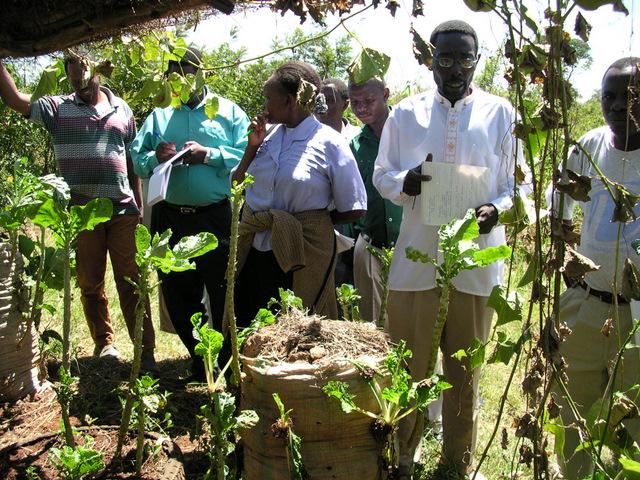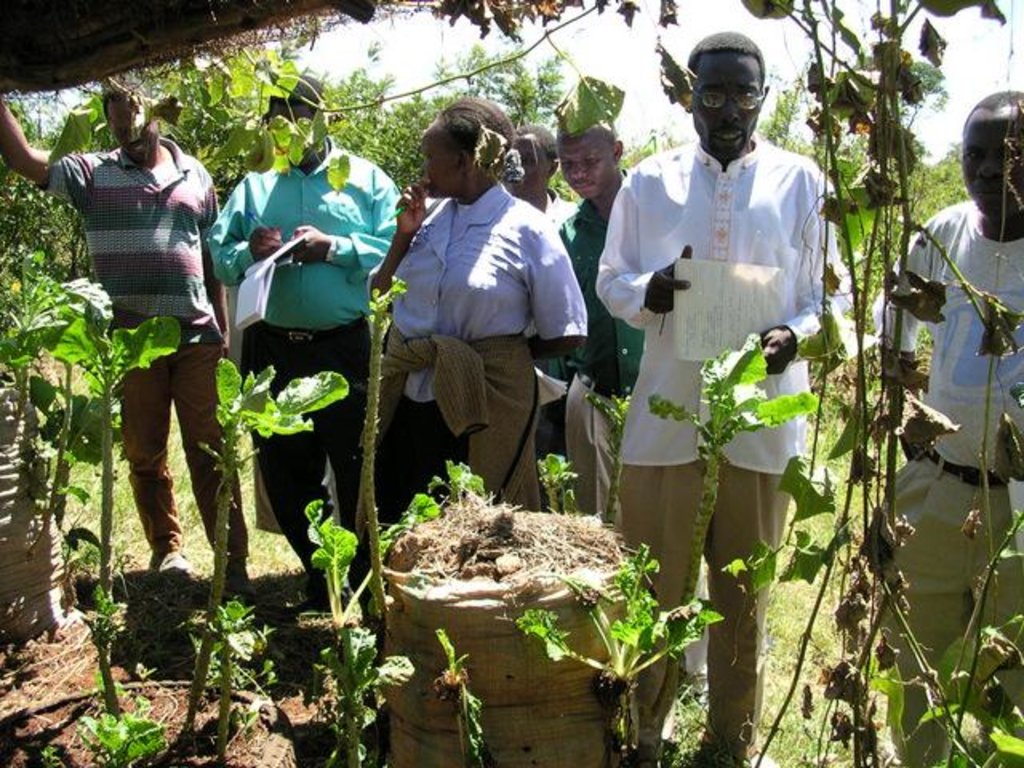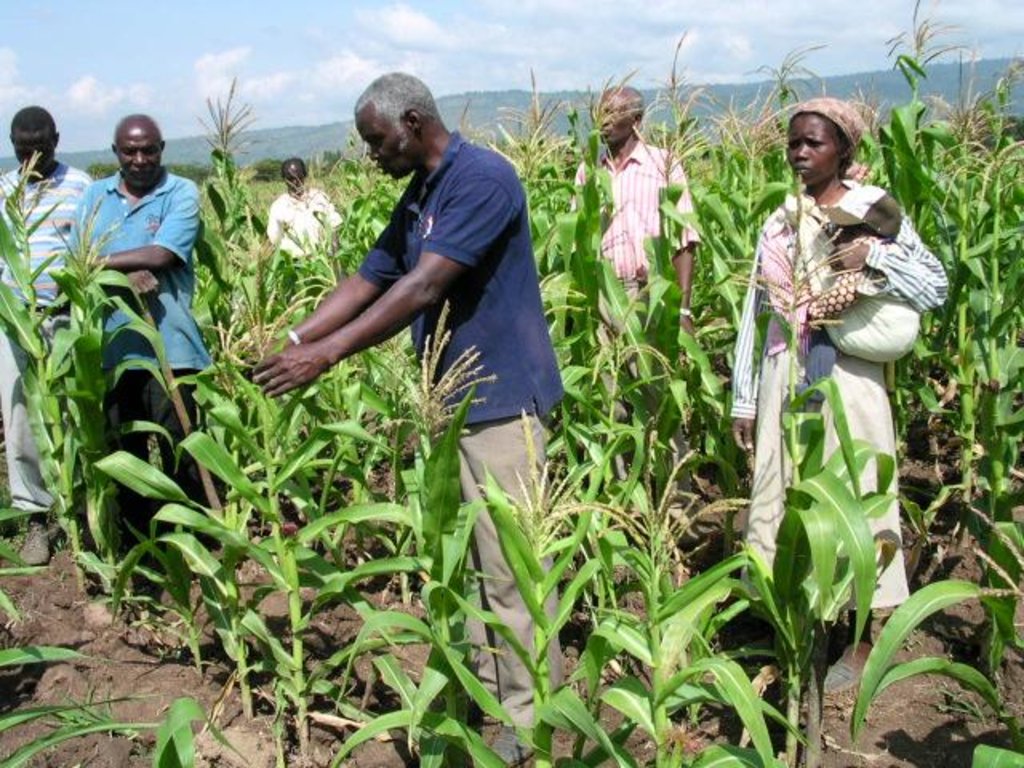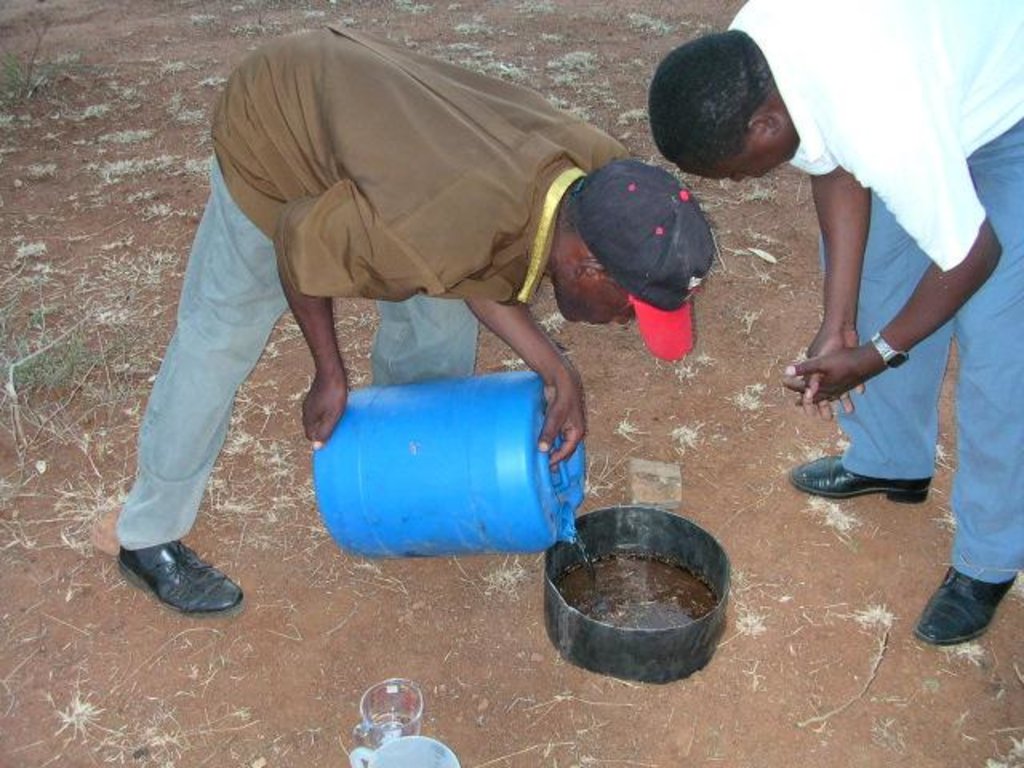Farmer Field Schools [Kenia]
- Creación:
- Actualización:
- Compilador: Philippe Zahner
- Editor: –
- Revisor: Fabian Ottiger
approaches_2569 - Kenia
Visualizar secciones
Expandir todo Colapsar todos1. Información general
1.2 Detalles de contacto de las personas de referencia e instituciones involucradas en la evaluación y la documentación del Enfoque
Especialista MST:
Duveskog Deborah
deborah.duveskog@gmail.com
FAO
Kenia
Especialista MST:
Nombre de la(s) institución(es) que facilitaron la documentación/ evaluación del Enfoque si fuera relevante)
Food and Agriculture Organization of the United Nations (FAO) - ItaliaNombre de la(s) institución(es) que facilitaron la documentación/ evaluación del Enfoque si fuera relevante)
Swiss Agency for Development and Cooperation (DEZA / COSUDE / DDC / SDC) - Suiza1.3 Condiciones referidas al uso de datos documentados mediante WOCAT
El compilador y la/s persona(s) de referencia claves aceptan las condiciones acerca del uso de los datos documentados mediante WOCAT :
Sí
1.4 Referencia/s al/los Cuestionario(s) de Tecnologías MST
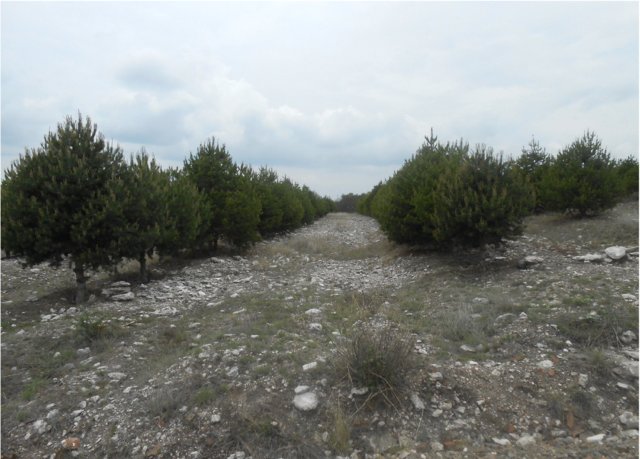
Callejones de piñón con forrajes intercalados [México]
La tecnología consiste en un sistema agrosilvopastoril con árboles de Pinus cembroides (pino piñonero) alineados en bordos ─en un terreno con suelos calizos previamente subsoleado─ conformando melgas (callejones) para sembrar cultivos anuales para grano y forraje, con pastoreo libre eventual por períodos muy breves.
- Compilador: BENJAMIN SANCHEZ BERNAL
2. Descripción del Enfoque MST
2.1 Breve descripción del Enfoque
A Farmer Field School (FFS) is a community-based practically-oriented field study programme.
2.2 Descripción detallada del Enfoque MST
Descripción detallada del Enfoque MST:
Aims / objectives: It is usually a time-bound activity (generally one agricultural production cycle), involving a group (commonly 20-30) of farmers, facilitated by agricultural advisors or – increasingly – by other farmers. The FFS provides an opportunity for farmers to learn together, using practical, hands-on methods of discovery-based and participatory learning.
Methods: The methods emphasise observation, discussion, analysis, collective decision-making, presentation and taking appropriate action. Discussion and analysis are important ways to combine local indigenous knowledge with new concepts and bring both into decision-making. The aim is to develop participants’ decision-making and problem solving capacity among farmers. The process builds self-confidence (particularly for women), encourages group control of the process, and builds management and leadership skills. Although FFS are time-bound, many groups formalise their relations and continue study or action projects, including FFS on other subjects, after the FFS learning cycle is completed. The Farmer Field Schools on Integrated Land and Water Management (ILWM) in eastern and central Kenya focus on learning about how to improve management of land and water resources both on individual plot and farm level and within ‘landscapes’ and communal lands; including local watersheds, river-valleys, forested hill-tops, grazing lands, eroded gullies etc. Each FFS group experiments practically on selected SLM practices/ measures. All learning takes place in the field and farmers usually meet once per week at a selected host farm in their locality to monitor their field experiments and to discuss emerging issues. Trained facilitators, usually agricultural advisors, guide farmers in their observation and analysis of what is taking place in the field. Local farmer innovations are identified to feed indigenous knowledge into the FFS process: Innovators visit FFS groups or FFS members visit innovators farms to share their knowledge.
Other important information: The FFS process combined with the promotion of farmer innovation has proven to contribute to strong and cohesive groups that are able to make informed decisions and change cultural and practical behaviour in order to improve their production and land management. The process also builds self-confidence, and empowers especially women to take on leadership roles in the community. The impacts observed of FFS thus have strong biophysical and social dimensions.
2.3 Fotos del Enfoque
2.5 País/ región/ lugares donde el Enfoque fue aplicado
País:
Kenia
Región/ Estado/ Provincia:
Eastern and Central Kenya
Especifique más el lugar :
Mwingi, Kitui and Nakuru Districts
Map
×2.7 Tipo de Enfoque
- proyecto/ basado en un programa
2.8 Propósitos/ objetivos principales del Enfoque
The Approach focused mainly on SLM with other activities (community organisational building for collective action and collective storage and marketing of products)
Support farmers’ knowledge levels and decision making capacity in relation to sustainable land and water management Raise farmers’ yields in a sustainable manner and ultimately contribute to increased net farm income Strengthen community organisation and collective efforts
The SLM Approach addressed the following problems: Land degradation, climatic variability and loss of agricultural biodiversity, Farmers focus on their own farms and income and lack of interest for wider watershed / environment
3. Participación y roles de las partes interesadas involucradas
3.1 Partes interesadas involucradas en el Enfoque y sus roles
- usuarios locales de tierras/ comunidades locales
- especialistas MST/consejeros agrícolas
- gobierno nacional (planificadores, autoridades)
Ministry of Agriculture
- organización internacional
FAO
3.2 Involucramiento de los usuarios locales de tierras/ comunidades locales en las distintas fases del Enfoque
| Involucramiento de los usuarios locales de tierras/ comunidades locales | Especifique quién se involucró y describa las actividades | |
|---|---|---|
| iniciación/ motivación | interactivo | |
| planificación | interactivo | |
| implementación | interactivo | |
| monitoreo y evaluación | ninguno | |
| Research | ninguno |
3.4 La toma de decisiones en la selección de Tecnología(s) MST
Especifique quién decidió la selección de las Tecnología/ Tecnologías a implementarse:
- principalmente usuarios de tierras con el apoyo de especialistas MST
Explique:
Decisions on the method of implementing the SLM Technology were made by mainly by land users supported by SLM specialists
4. Apoyo técnico, fortalecimiento institucional y gestión del conocimiento
4.1 Construcción de capacidades / capacitación
¿Se proporcionó la capacitación a usuarios de tierras/ otras partes interesadas?
Sí
Especifique quién fue capacitado:
- usuarios de tierras
- personal de campo/ consejeros
Forma de capacitación:
- de agricultor a agricultor
- cursos
Temas avanzados:
Agricultural advisors were trained in the FFS approach and in ILWM topics through a total of four weeks of training. Farmers were trained in FFS through season-long FFS learning where farmers meet at a host-farm weekly to carry study activities.
4.2 Servicio de asesoría
¿Los usuarios de tierras tienen acceso a un servicio de asesoría?
Sí
Especifique si servicio proporcionado se realizó:
- en los campos de los usuarios de tierras
Describa/ comentarios:
Name of method used for advisory service: Participatory extension; Participatory extension with season-long regular interaction between farmers and agricultural advisors. At a later stage also strong farmer-to-farmer extension
The approach requires an attitude shift among agricultural extension workers to become more client-orientated.
4.5 Investigación
¿La investigación formó parte del Enfoque?
Sí
5. Financiamiento y apoyo material externo
5.1 Presupuesto anual para el componente MST del Enfoque
Si no se conoce el presupuesto anual preciso, indique el rango:
- 100,000-1,000,000
Comentarios (ej. fuentes principales de financiamiento/ donantes principales):
Approach costs were met by the following donors: international: 60.0%; government: 20.0%; local community / land user(s): 20.0%
5.3 Subsidios para insumos específicos (incluyendo mano de obra)
Si la mano de obra de usuarios de tierras fue un insumo sustancial, ¿fue:
- voluntario?
5.4 Crédito
¿Se proporcionó crédito bajo el Enfoque para actividades MST?
No
6. Análisis de impacto y comentarios de conclusión
6.1 Impactos del Enfoque
¿El Enfoque ayudó a los usuarios de tierras a implementar y mantener Tecnologías MST?
- No
- Sí, un poco
- Sí, moderadamente
- Sí, mucho
yield increase of more than 200% has been recorded frequently
Did other land users / projects adopt the Approach?
- No
- Sí, un poco
- Sí, moderadamente
- Sí, mucho
the applied practices have spread from participants to neighbours in the community
Did the Approach lead to improved livelihoods / human well-being?
- No
- Sí, un poco
- Sí, moderadamente
- Sí, mucho
improved gender relations and division of farm workload, resistance to drought and improved livelihoods and life satisfaction in general
Did the Approach help to alleviate poverty?
- No
- Sí, un poco
- Sí, moderadamente
- Sí, mucho
all participants fall in the poor or medium poor category and therefore the project has contributed to reduced poverty levels
6.2 Motivación principal del usuario de la tierra para implementar MST
- producción incrementada
- incremento de la renta(bilidad), proporción mejorada de costo-beneficio
- prestigio, presión social/ cohesión social
- afiliación al movimiento/ proyecto/ grupo/ redes
- friendship and collective spirit among group membe
6.3 Sostenibilidad de las actividades del Enfoque
¿Pueden los usuarios de tierras sostener lo que se implementó mediante el Enfoque (sin apoyo externo)?
- sí
Si respondió que sí, describa cómo:
Graduated FFS groups have organised themselves into a network and farmer organisations that have taken on collective activities following the end of the initial project. In some cases this has included starting up self-financed new FFS groups.
6.4 Fortalezas/ ventajas del Enfoque
| Fuerzas/ ventajas/ oportunidades desde la perspectiva del compilador o de otra persona de referencia clave |
|---|
| The collective action created in communities to deal with and manage their own resources. |
| Improved capacity of farmers for problem solving and innovation in ISWM. |
6.5 Debilidades/ desventajas del Enfoque y formas de sobreponerse a ellos
| Debilidades/ desventajas/ riesgos desde la perspectiva del compilador o de otra persona de referencia clave | ¿Cómo sobreponerse a ellas? |
|---|---|
| A top-down and patronising attitude towards farmers are common among agricultural staff and experts, which prevents equal and trustful relationships | Institutionalisation of participatory extension is thus needed with a change in mindset among government and other agricultural support staff. |
| The various government bodies and ministries responsible for land and water issue often operate individually without strong synergie | A stronger collaboration is needed between ministries especially Ministry of Water and Ministry of Agriculture in order to deal effectively with land and water aspects in an integrated manner. |
7. Referencias y vínculos
7.1 Métodos/ fuentes de información
- visitas de campo, encuestas de campo
- entrevistas con usuarios de tierras
7.2 Referencias a publicaciones disponibles
Título, autor, año, ISBN:
Duveskog D. 2001. Adapted from A Study Guide for Farmer Field Schools: Water Harvesting and Soil Moisture Retention.FAO-IIRR. 2006. Discovery-based Learning on Land and Water Management: Practical Guide for Farmer Field Schools.
Vínculos y módulos
Expandir todo Colapsar todosVínculos

Callejones de piñón con forrajes intercalados [México]
La tecnología consiste en un sistema agrosilvopastoril con árboles de Pinus cembroides (pino piñonero) alineados en bordos ─en un terreno con suelos calizos previamente subsoleado─ conformando melgas (callejones) para sembrar cultivos anuales para grano y forraje, con pastoreo libre eventual por períodos muy breves.
- Compilador: BENJAMIN SANCHEZ BERNAL
Módulos
No se hallaron módulos


